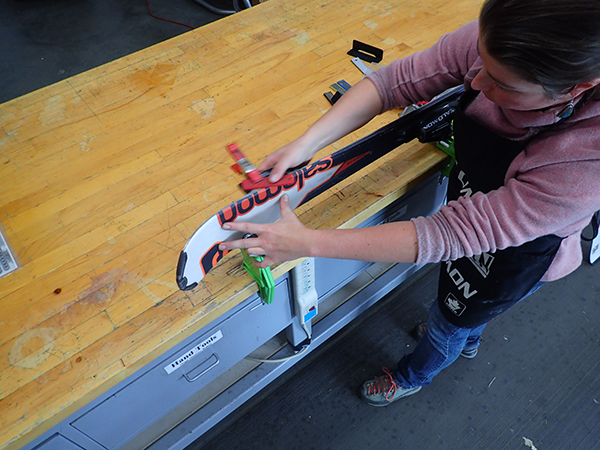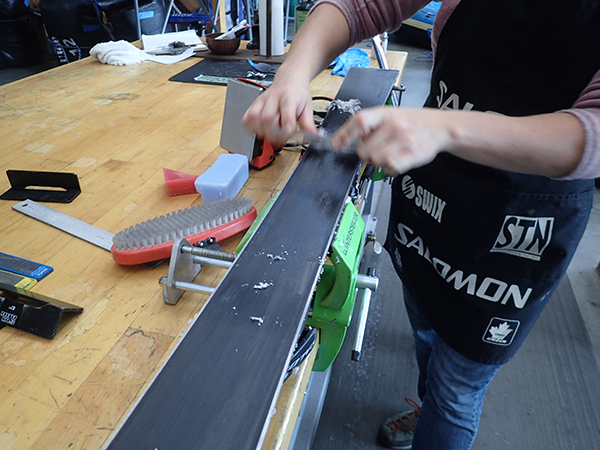As someone who loves skiing, I know that there is always ways to improve my skiing ability, and therefore maximise my fun and enjoyment of the mountains every season. From short turns and carving over park skiing to waist-deep powder: It only takes a small break-through in your technique to put a smile on your face! We asked a long-time ski instructor to list nine ways that the average person can use to improve their skiing this winter:
1. Short Turns
A useful skill to master, short turns are parallel turns in quick succession, mainly used on narrow runs. This elegant technique keeps you traveling down the slope at a constant speed overall.
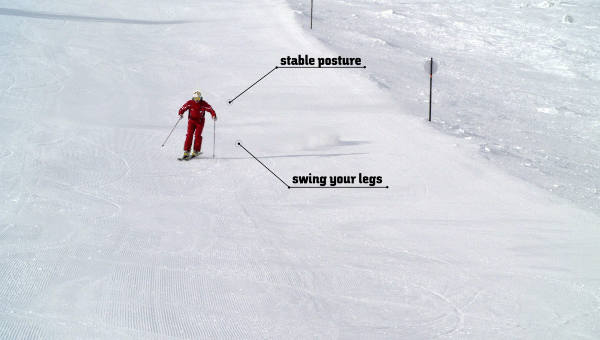
Nik’s Tip: Turn the skis with your legs. A solid, centred stance and good edging movements will allow your legs to make all the movements and help keep your upper body still. Imagine skiing through a tiny tunnel where you have a duck to avoid banging your head. A useful exercise is the hockey stop, which is basically a parallel turn into sliding sideways until you stop. The hockey stop is the most efficient way to stop, as it gives the maximum resistance possible.
2. Carving
For skiers who love speed, ripping down a hill with a true carve is one of a skiing’s most graceful maneuvers. True edge-to-edge carving is meant primarily for wide-open groomers.
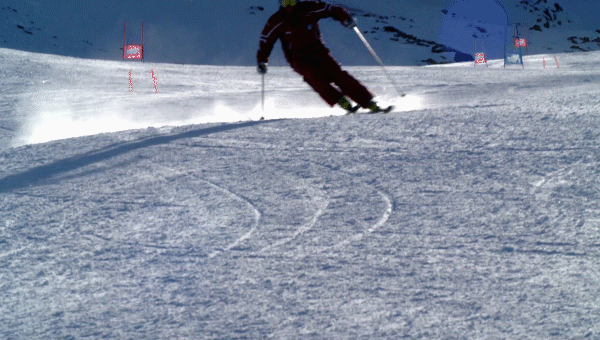
Nik’s Tip: To carve the perfect turn, you need to get your skis on edge as early in the turn as possible. This is best done as you are pointing straight down the slope, by rolling the knees over so that the ski edges dig into the snow and steer the skis across the slope. The skis need to be put on the edges enough that when they start turning the skis will “cut” into the snow and not slide or drift. This means changing your weight from ski to ski early and then inclining your body to put your skis on edge. Once you are balanced on your outside ski, extend your legs from under your body so that your body is inclined down the hill – ensure your body is straight, not bent in the waist. With a little bit of practice you will soon be able to enjoy the centrifugal forces at work during the parabolic curves.
3. Steeps
Skiing Steeps is an exhilarating and challenging experience, but it requires high degrees of both confidence and control.
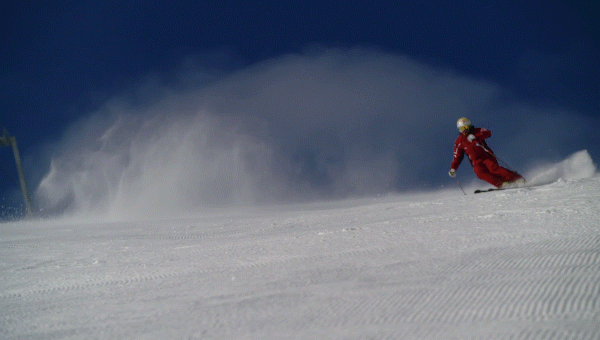 Nik’s Tip: Less experienced skiers can use slide sideways to go down a slope in a very steep traverse: Weight over the downhill ski with the upper body facing the direction of your descent. Experienced skiers use upward and downward movement to help power the skis through the turns. This is used a bit like a jump, as the skis come across the slope our body weight has been thrown upwards from the last turn and there is not so much pressure on the skis. Swing your skis round across the fall line to check your speed. This technique can be a remarkable addition to your bag of tricks, however, it requires a bit of practice. Useful exercises are side slipping and the hockey stop.
Nik’s Tip: Less experienced skiers can use slide sideways to go down a slope in a very steep traverse: Weight over the downhill ski with the upper body facing the direction of your descent. Experienced skiers use upward and downward movement to help power the skis through the turns. This is used a bit like a jump, as the skis come across the slope our body weight has been thrown upwards from the last turn and there is not so much pressure on the skis. Swing your skis round across the fall line to check your speed. This technique can be a remarkable addition to your bag of tricks, however, it requires a bit of practice. Useful exercises are side slipping and the hockey stop.
4. Difficult Conditions
There are days when you will find that it is extremely icy in the morning, and as the day goes on the snow will start to melt, and runs can become very lumpy very quickly. Here are a few tips by Nik that just might help you up your game.
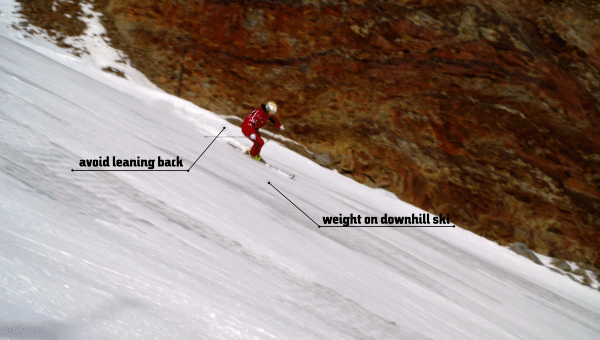
Nik’s Tip: If the slopes are icy, keep your speed down. Try to use your edges as much as possible and put weight over the downhill ski. If necessary, you can always use slide sideways to go down an icy slope. With soft snow conditions, the snow can be moved around a lot and this is when the moguls really start to be made. With the soft snow, though, the skis will normally have a lot of control as the edges can dig into the snow well, and you can use the bumps to initiate your next turn. Keep your legs close together all the time.
5. Freestyle Skiing: Switch, Jumps, Rails & Boxes
Freestyle skiing looks amazing, and will give you one of the biggest buzzes you will ever feel on the snow. However, how on earth do you make the transition from scooting about on-piste to launching yourself off the jumps, rails and boxes of a terrain park? A very important maneuver is the ability to ski backwards, or switch.
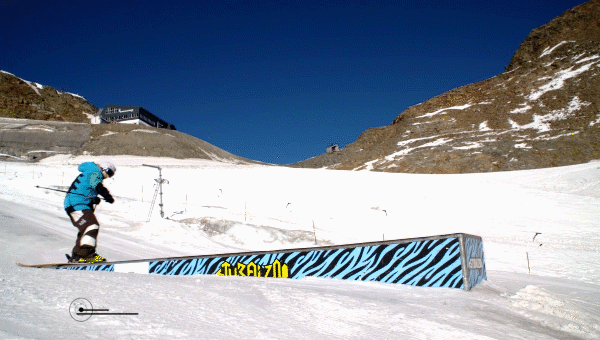
Nik’s Tip: Perform basic parallel turns switch on an easy and wide-open slope. Initiate a switch turn by looking in the direction of travel, a basic tenet in switch skiing. When hitting a kicker in a terrain park, start with a straight jump. When you hit the take-off ramp, you will need to lean forwards in order to keep your weight over the middle of the skis. Practise springing off of smaller jumps until you are capable and confident enough to try something bigger. Find a suitable place to perform your first spins – as you are rotating in the air, look down at the ground and evaluate your landing spot. The 50/50 slide or straight run over the box is the first and easiest maneuver to try. Try to stay right on your center and glide it out. Edging will be ineffective and result in a fall! After mastering the slide (straight run) over the fun box, the next maneuver to try in the progression is the board slide. Hop onto the box surface simultaneously rotating the lower body to place the skis in a 90-degree side slide and counter rotate the upper body to stop the lower body rotation at 90 degrees. Always check out the features first—boxes are slippery and easy to fall off of.
6. Mogul Skiing
To ski moguls well you have to be able to get a real feel for what you are doing, and be able to attack the moguls with confidence whatever they are like. This is the supreme ski discipline and can only be achieved through practice. To ski through moguls you should have mastered short turns (see #1).
 Nik’s Tip: Use the ‘up force’ of the bump to gently turn your skis around it. As your skis reach each bump, let your knees compress upwards towards your chest. You do this by turning your feet downhill after cresting the bump. This is called the “absorption technique”. Keep your legs close together and ski in the troughs between two moguls. Start off by making downhill absorption turns on small moguls on easy slopes and then make them on bigger moguls on gradually steeper slopes.
Nik’s Tip: Use the ‘up force’ of the bump to gently turn your skis around it. As your skis reach each bump, let your knees compress upwards towards your chest. You do this by turning your feet downhill after cresting the bump. This is called the “absorption technique”. Keep your legs close together and ski in the troughs between two moguls. Start off by making downhill absorption turns on small moguls on easy slopes and then make them on bigger moguls on gradually steeper slopes.
7. Common Mistakes
Leaning back, inclination, twisting: When people learn to ski there are many common mistakes that they make, here are three of the most common mistakes listed with advice on what to try to stop yourself making them.

Nik’s Tip: If you shift your center of mass backwards you will soon find your muscles and legs talking back to you. Using a tall stance by keeping your legs long reduces the need for crouching and/or substantial absorption or extension movements, which means that you will experience much less fatigue when skiing. Your weight should be forward so that your shins push on the front of the ski boots and the skis press evenly into the snow. A useful exercise is to ski with your hands forward. Many skiers lean up the hill (inclination) at the end of a turn, which results in an unstable situation because their balance is on the inside, uphill ski rather than on the outside, downhill ski. At every turn, imagine you have to press a red button on the outside of the turn. The body should be looking over the downhill ski, with the shoulders at the same angle as the tips of the skis. Twisting the upper body is often a more subconscious mistake that people don’t really realise that they are doing. To avoid this twisting, the inner shoulder has to turn more.
8. Powder Skiing
Gliding through fresh powder is undoubtedly the finest feeling on skis if you know what you’re doing! The following powder tips are intended to help you master the art of cruising through the ‘deep stuff’.

Nik’s Tip: There is more resistance in powder, so in the deeper snow, build up enough speed before establishing a ‘bouncing’ rhythm by unweighting, turning and weighting both skis simultaneously. Do not force the skis to turn or jump them – instead wait for the snow to build up a ‘springboard’ under your skis at the end of your turn, before using this force to unweight your skis and allow you to lift up above the powder and immerse yourself once again. Build up a fluid rhythm of short, even turns – rhythm being the key to powder skiing and will, in the deeper stuff, allow the snow to make the turn for you. Banish the myth that you ‘must lean back’! Special ‘powder skis’ are very wide and often have a rocker design at the tip and at the tail, making powder skiing much easier. Skiing off-piste also presents the danger of avalanches, thus powder skiing is best done in groups, with everyone equipped with appropriate avalanche equipment.
9. Off-Piste/Backcountry Safety Tips
Backcountry terrain is a fantastic place to play. Review and keep the tips below in your mind before you head beyond the ski area boundaries for the day to ensure a fun and safe experience.
 Nik’s Tip: First thing in the morning, check your local avalanche center website to get your local Avalanche Forecast. Educate yourself on how to reduce the risk of injury or death from avalanches through your own actions and awareness. If you venture into backcountry/avalanche terrain, carry all required safety equipment, including transceiver/beacon, shovel, probe, first aid kit and a mobile phone to call for help. Using an avalanche airbag increases your chances of staying on top of an avalanche. Be aware that your gear helps you have a safer and more fun day – it does not guarantee your safety. Always ski or ride with a partner and keep your partner in sight at all times. Carry the avalanche transceiver – turned on! – on your body, all the time and perform a final avalanche transceiver check before you begin your adventure. Practice with your backcountry safety gear regularly and remember that your gear only works when you can use it confidently and efficiently in bad conditions. Take an avalanche safety course and learn the backcountry basics regularly. If you are on vacation, get the most out of your trip by hiring a professional backcountry guide. He will customize the experience to your requests and create a fun, safe, educational day in the backcountry.
Nik’s Tip: First thing in the morning, check your local avalanche center website to get your local Avalanche Forecast. Educate yourself on how to reduce the risk of injury or death from avalanches through your own actions and awareness. If you venture into backcountry/avalanche terrain, carry all required safety equipment, including transceiver/beacon, shovel, probe, first aid kit and a mobile phone to call for help. Using an avalanche airbag increases your chances of staying on top of an avalanche. Be aware that your gear helps you have a safer and more fun day – it does not guarantee your safety. Always ski or ride with a partner and keep your partner in sight at all times. Carry the avalanche transceiver – turned on! – on your body, all the time and perform a final avalanche transceiver check before you begin your adventure. Practice with your backcountry safety gear regularly and remember that your gear only works when you can use it confidently and efficiently in bad conditions. Take an avalanche safety course and learn the backcountry basics regularly. If you are on vacation, get the most out of your trip by hiring a professional backcountry guide. He will customize the experience to your requests and create a fun, safe, educational day in the backcountry.
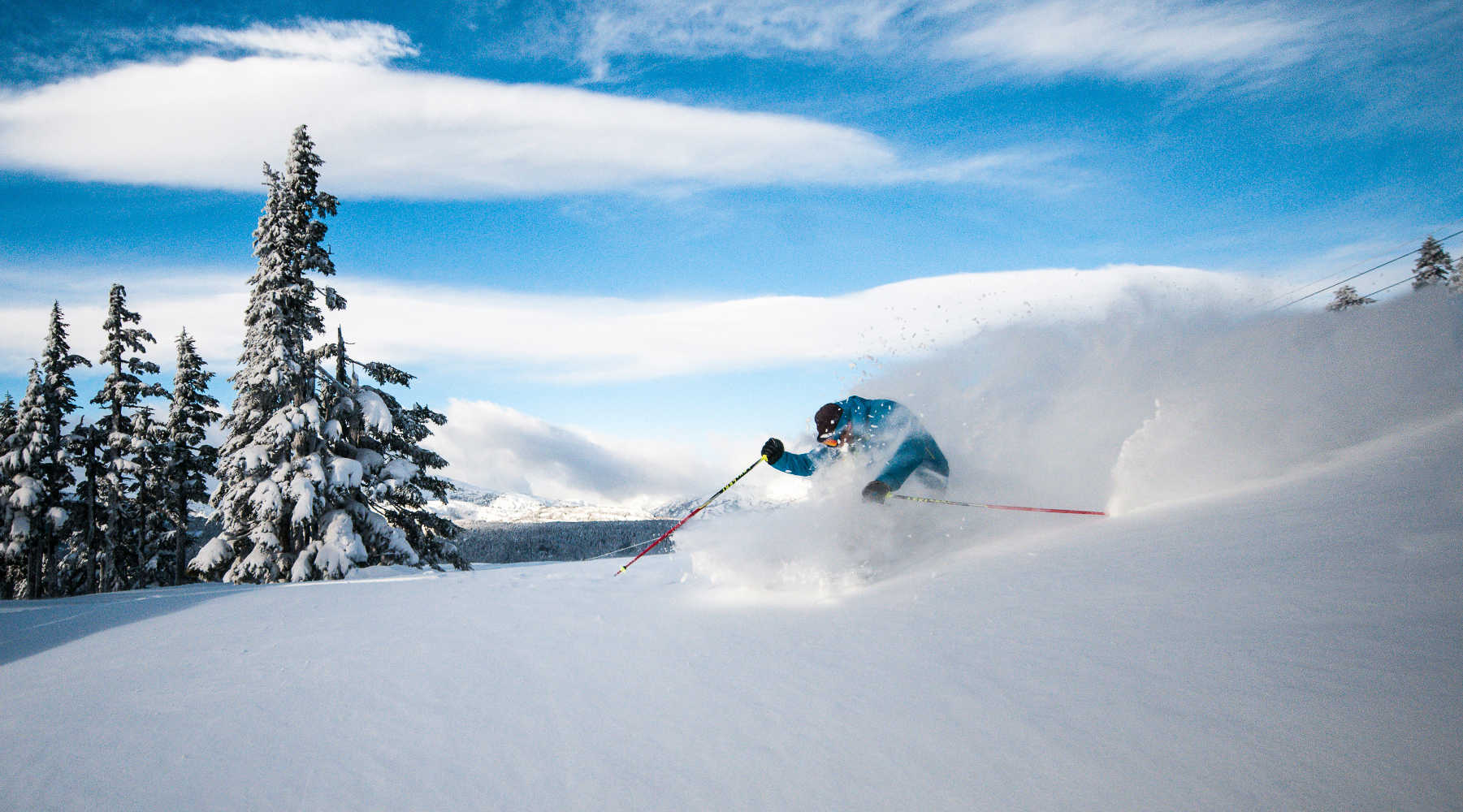


 Nik’s Tip: Less experienced skiers can use slide sideways to go down a slope in a very steep traverse: Weight over the downhill ski with the upper body facing the direction of your descent. Experienced skiers use upward and downward movement to help power the skis through the turns. This is used a bit like a jump, as the skis come across the slope our body weight has been thrown upwards from the last turn and there is not so much pressure on the skis. Swing your skis round across the fall line to check your speed. This technique can be a remarkable addition to your bag of tricks, however, it requires a bit of practice. Useful exercises are side slipping and the hockey stop.
Nik’s Tip: Less experienced skiers can use slide sideways to go down a slope in a very steep traverse: Weight over the downhill ski with the upper body facing the direction of your descent. Experienced skiers use upward and downward movement to help power the skis through the turns. This is used a bit like a jump, as the skis come across the slope our body weight has been thrown upwards from the last turn and there is not so much pressure on the skis. Swing your skis round across the fall line to check your speed. This technique can be a remarkable addition to your bag of tricks, however, it requires a bit of practice. Useful exercises are side slipping and the hockey stop.

 Nik’s Tip: Use the ‘up force’ of the bump to gently turn your skis around it. As your skis reach each bump, let your knees compress upwards towards your chest. You do this by turning your feet downhill after cresting the bump. This is called the “absorption technique”. Keep your legs close together and ski in the troughs between two moguls. Start off by making downhill absorption turns on small moguls on easy slopes and then make them on bigger moguls on gradually steeper slopes.
Nik’s Tip: Use the ‘up force’ of the bump to gently turn your skis around it. As your skis reach each bump, let your knees compress upwards towards your chest. You do this by turning your feet downhill after cresting the bump. This is called the “absorption technique”. Keep your legs close together and ski in the troughs between two moguls. Start off by making downhill absorption turns on small moguls on easy slopes and then make them on bigger moguls on gradually steeper slopes.

 Nik’s Tip: First thing in the morning, check your local avalanche center website to get your local
Nik’s Tip: First thing in the morning, check your local avalanche center website to get your local 